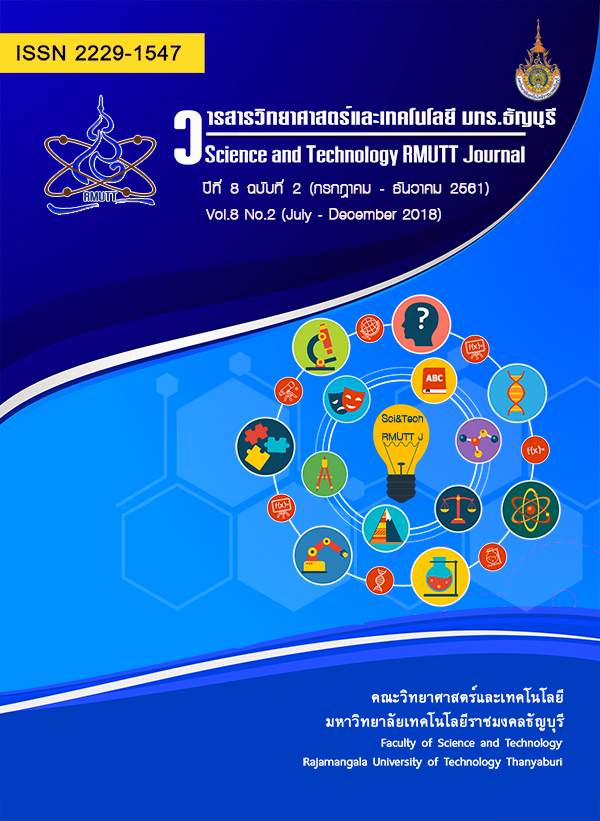Biological Nitrogen Removal via Nitrite by Shortcut Nitrification-Denitrification Process in Sequencing Batch Biofilm Reactor
Main Article Content
Abstract
A sequencing batch biofilm reactor (SBBR) was operated to remove carbon and nitrogen from synthetic wastewater with a carbon-nitrogen ratio of 5. This reactor was operated sequentially under 4 hours anaerobic and 12 hours aerobic conditions in one cycle. The results showed that 95.42% of COD was removed under anaerobic condition, while 90.68% of ammonium was oxidized under aerobic condition by without nitrite and nitrate accumulation in the effluent. These phenomena were demonstrate by denitrifying glycogen accumulating organism (DGAO) and nitrifying bacteria with coexist in biofilm. The coexistence of these microorganisms resulted in shortcut nitrification-denitrification process in the reactor. Therefore, ammonium was oxidized to nitrite by nitrifying bacteria after that nitrite was utilized as an electron acceptor by DGAO at utilization rate of 0.94 g N/m2-d. However, concentration of nitrite higher than 5.0 mg N/L could inhibit the activity of DGAO.
Article Details
References
Aslan S. and Dahab M. Nitritation and denitritation of ammonium-rich wastewater using fluidized-bed biofilm reactors. Journal of Hazardous Materials. 2008. 156 : 56–63.
Zeng W., Li L., Yang Y., Wang S. and Peng Y. Nitritation and denitritation of domestic wastewater using a continuous anaerobic–anoxic–aerobic (A2O) process at ambient temperatures. Bioresource Technology. 2010. 101 : 8074-8082.
Abeling U. and Seyfried C.F. Anaerobic-aerobic treatment of high-strength ammonium wastewater-nitrogen removal via nitrite. Water Science and Technology. 1992. 26(5-6) : 1007-1015.
Glass C., Silverstein J.A. and Oh J. Inhibition of denitrification in activated sludge by nitrite. Water Environment Research. 1997. 69(6) : 1086-1093.
Zhang L., Wei C., Zhang K., Zhang C., Fang Q. and Li S. Effects of temperature on simultaneous nitrification and denitrification via nitrite in a sequencing batch biofilm reactor. Bioprocess and Biosystems Engineering. 2009. 32(2) : 175-182.
Seifiab M. and Fazaelipoora M.H. Modeling simultaneous nitrification and denitrification (SND) in a fluidized bed biofilm reactor. Applied Mathematical Modelling. 2012. 36(11) : 5603-5613.
Terada A., Hibiya K., Nagai J., Tsuneda S. and Hirata A. Nitrogen removal characteristics and biofilm analysis of a membrane-aerated biofilm reactor applicable to high-strength nitrogenous wastewater treatment. Journal Bioscience and Bioengineering. 2003. 95(2) : 170-178.
Matsumoto S., Terada A. and Tsuneda S. Modeling of membrane-aerated biofilm: Effects of C/N ratio, biofilm thickness and surface loading of oxygen on feasibility of simultaneous nitrification and denitrification. Biochemical Engineering Journal. 2007. 37(1) : 98-107.
Semmens M.J., Dahm K., Shanahan J. and Christianson A. COD and nitrogen removal by biofilms growing on gas permeable membranes. Water Research. 2003. 37(18) : 4343-4350.
Wei X., Li B, Zhao S., Qiang C., Zhang H. and Wang S. COD and nitrogen removal in facilitated transfer membrane-aerated biofilm reactor (FT-MABR). Journal of Membrane Science. 2012. 389 : 257-264.
ขวัญเนตร สมบัติสมภพ. การบำบัดน้ำเสียด้วยระบบเอสบีอาร์. วารสารวิชาการพระจอมเกล้าพระนครเหนือ. 2551. 18(3) : 96-103.
ธงชัย พรรณสวัสดิ์. การกำจัดไนโตรเจนและฟอสฟอรัสทางชีวภาพ. กรุงเทพฯ: สมาคมวิศวกรรมสิ่งแวดล้อมแห่งประเทศไทย; 2544.
Soejima K., Oki K., Terada A., Tsuneda S. and Hirata A. Effects of acetate and nitrite addition on fraction of denitrifying phosphate-accumulating organisms and nutrient removal efficiency in anaerobic/aerobic/anoxic process. Bioprocess and Biosystems Engineering. 2006. 29 : 305-313.
APHA, AWWA, and WEF. Standard methods for the examination of water and wastewater. 20th ed. American Public Health Association, Washington. 1998.
He S., Gu A.Z. and McMahon K.D. Progress toward understanding the distribution of Accumulibacter among full-scale enhanced biological phosphorus removal systems. Microbial Ecology. 2008. 55 : 229-236.
Coma M., Verawaty M., Pijuan M., Yuan Z. and Bond P.L. Enhancing aerobic granulation for biological nutrient removal from domestic wastewater. Bioresource Technology. 2012. 103 : 101-108.
Zeng R.J., Yuan Z. and Keller J. Enrichment of denitrifying glycogen-accumulating Organisms in anaerobic/anoxic activated sludge system. Biotechnology and Bioengineering. 2003. 81(4) : 397-404.
Syron E., Semmens M.J. and Casey E. Performance analysis of a pilot-scale membrane aerated biofilm reactor for the treatment of landfill leachate. Chemical Engineering Journal. 2015. 273 : 120-129.


